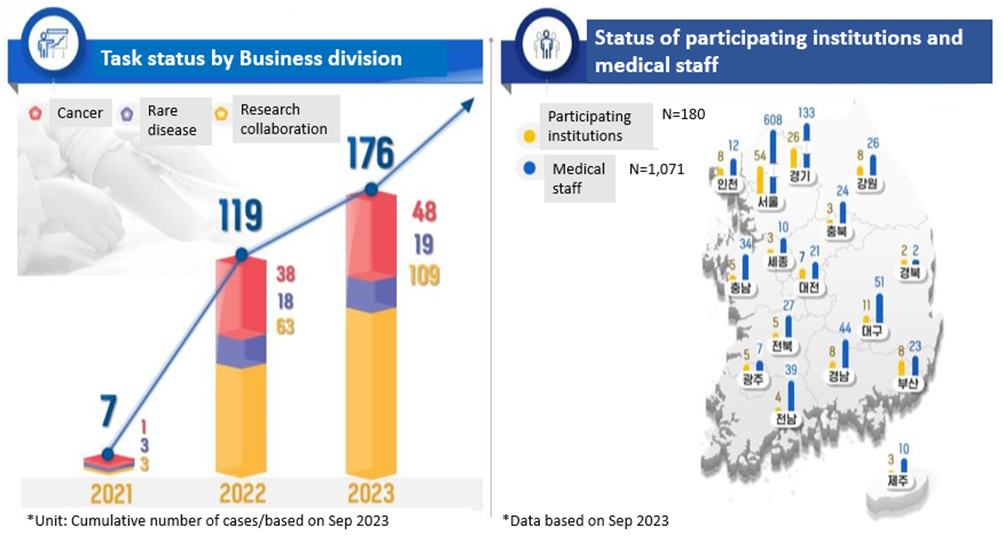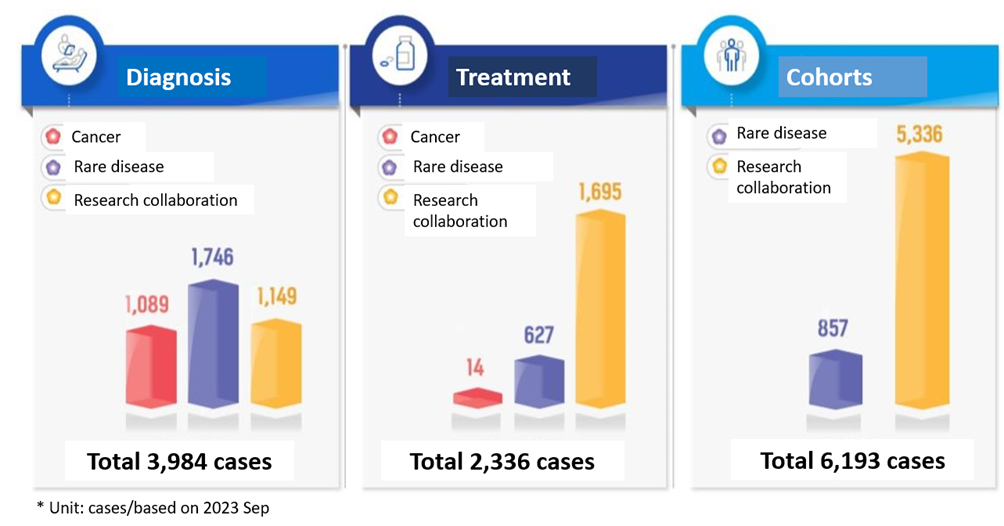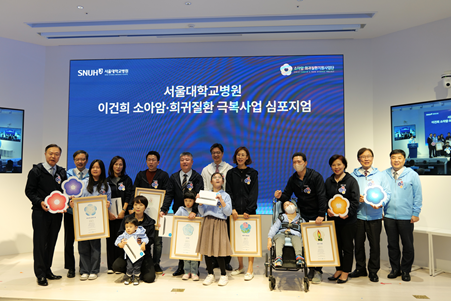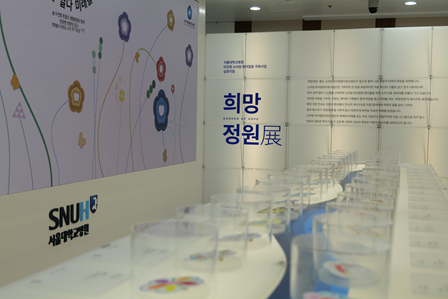Lee Kun-Hee foundation project to overcome childhood cancer and rare diseases...Sowing seeds of hope
Lee Kun-Hee foundation project to overcome childhood cancer and rare diseases...Sowing seeds of hope
- Joining forces to overcome childhood cancer and rare diseases... 1,071 medical staff from 160 medical institutions nationwide participated
- A total of 176 projects were carried out over 3 years, including 48 pediatric cancer cases, 19 pediatric rare diseases, and 109 joint research projects.
- 3,984 diagnoses, 2,336 treatments, 6,193 cohorts... Plan to establish standardized treatment nationwide

|
<#> Case of pediatric cancer patient Yuri (pseudonym, 17 years old) visited a nearby pediatrician 4 years ago with a sudden onset of fever and red skin spots. Blood test results showed that the white blood cell count was abnormally high. She was diagnosed with ‘acute lymphocytic leukemia’, a type of blood cancer, at a major hospital. It is a disease in which the average lifespan is only 6 months without chemotherapy because white blood cells that have turned into cancer cells proliferate in the bone marrow and travel through the blood to invade various parts of the body. At first, her parents were worried about Yuri and hid the name of her illness. Yuri, who was hopeful that she would get better after a few days in the hospital, was crushed when she found out a month later that she was a cancer patient. While her friends entered junior high school and took classes, Yuri endured three years of chemotherapy.
Just before she reached the end of chemotherapy treatment, another difficulty came. Two years after completing chemotherapy, her leukemia recurred. To treat her condition, Yuri received a transplant of her brother's hematopoietic stem cells, but she had to be admitted to the intensive care unit because of a side effect of hepatic vein syndrome. More than the fear of being alone in the intensive care unit, the worry that she might have to undergo chemotherapy again made the ordeal even more difficult for her.
Nevertheless, Yuri says that she was able to endure the treatment thanks to the support of those around her. In particular, the nurse provided great support in the intensive care unit where even parents were not allowed to enter during the COVID-19 pandemic. The nurse’s encouragement, “If anything is difficult, tell me. I will always be by your side,” offered Yuri courage.
There was another support. For Yuri, who needs to periodically undergo a bone marrow test for microscopic residual cancer to predict recurrence, the Lee Gun-Hee Foundation stepped in to support the cost of the test (the cost of each test amounts to 1 million won). Thanks to this, Yuri was able to receive seven tests free of charge and consistently track her complete recovery. Yuri, who has since improved, has returned to her daily life and is receiving blood tests every month for further observation.
Now, Yuri hopes that her friends will receive as much support as she did in the past and that they will be able to find good health with a positive mind. She dreams of becoming a nurse who gives hope to other sick children. |
|
<#> Pediatric rare disease & joint research patient cases
Jungwoo (pseudonym, 5 years old) began to strangely experience cold sweats from birth. Even though his parents fanned him all night, his sweat did not dry. When he was about 8 months old, he started eating formula, and to make matters worse, diarrhea that did not respond to medication became more frequent and a rash on his buttocks became more severe. The parents went to the local hospital, worried that something might be wrong with the child, and were told that Jungwoo's blood sugar level was 30 and his liver count was high, so they needed to go to a bigger hospital. He underwent various tests and a liver biopsy at the fourth hospital his parents visited.
It was found Jungwoo suffered ‘Glycogen Storage Disease’, which is said to affect 1 in 100,000 people. This genetic disease is rare and incurable, caused by a deficiency of an enzyme that occurs in the process of storing or using sugar. Jungwoo could not eat snacks or ice cream that his friends liked. Instead, maintaining appropriate blood sugar was important, so he had to eat starch 12 times a day. Now that he is older, he eats 7 times with an increased portion size, but it the process of regularly eating starch is still difficult for him.
Additionally, he suffered an increased risk of hypoglycemic shock and had to measure his blood sugar levels dozens of times a day. Jungwoo's arms and feet were bruised repeatedly. Seeing Jungwoo in pain, was as if looking upon someone left alone in a dark tunnel.
However, Jungwoo's family found a breakthrough. Jungwoo received support from the Lee Gun-Hee Foundation for a continuous blood sugar monitor that can easily check his blood sugar and life rhythm. Blood sugar management has become much easier, and Jungwoo now goes to daycare and plays air bounce with his friends.
The role of the Lee Gun-Hee Foundation does not end here. With the support of the project group, research is also being conducted to analyze data to improve the interference of the disease with children's daily lives. There will continue to be sick children in the future, and we dream of a world where we can use this accumulated data to formulate better treatments. Although currently still himself a patient, Jungwoo, who contributes to creating standard treatments by providing data, is now a donor, too. |
Rare pediatric illnesses and pediatric cancer are highly recurrent and challenging to treat. Over 7,000 distinct kinds of uncommon pediatric illnesses have been found. However, the small patient population and greater diversity of diseases compared to adult patients make it challenging to gather cases for pediatric patients. Patients and their families are severely burdened as a result of the inability to secure insurance benefits and the difficulty in establishing a standard treatment plan.
At this time, following the wishes of the late Chairman Lee Kun-Hee, the bereaved family made a meaningful decision to help children suffering from cancer and rare diseases. We decided to provide practical help by supporting treatment costs for child patients, while also sponsoring research to overcome childhood cancer and rare diseases. That intention led to an unprecedented donation of 300 billion won in 2021.
Accordingly, medical staff from all over the country gathered together, centered around Seoul National University Children's Hospital. And now it has been three years since the project was launched. What changes has it brought to our society?
Seoul National University Hospital (Director Kim Young Tae) held the 'Together, Opening the Hope. Opening the Future' symposium at the Biomedical Research Institute Yoon Deok-Byeong Hall on November 8th to deliver hope for overcoming childhood cancer and rare diseases and to promote the growth of participating medical staff and institutions across the country.
At the event, National Assembly member Choi Jae-Hyung, Samsung Social Contribution President Choi Young Moo, Seoul National University Hospital Director Kim Young Tae, Pediatrics Vice Director Choi Eun Hwa, and Kim Han Seok, Head of the Pediatric Cancer and Rare Disease Business Unit were attended.
The Pediatric Cancer and Rare Disease Project Group was established in May 2021 with donations from the Lee Kun-Hee Foundation. The purpose of this project is to build a treatment platform that provides practical benefits to child patients across the country suffering from pediatric cancer and rare pediatric diseases over a period of 10 years from 2021 to 2030. The goal is to create a foundation for overcoming childhood cancer and rare diseases by building a joint database through problem-solving research projects rather than providing one-time treatment cost support.
The project group is divided into three divisions respectively allocated: ▲Children's cancer KRW 150 billion (non-covered high-cost genomic testing fees and immune/targeted anti-cancer drugs, etc.) ▲ Pediatric rare disease KRW 60 billion (rare/emergency genomic testing, expensive gene therapy and new drug treatment for extremely rare diseases, etc.) ▲Pediatric joint research A budget of 90 billion won (diagnosis, treatment technology, pharmaceutical research and development, etc.). The foundation is working to fundamentally solve childhood cancer and rare diseases.

[Graph] Projects progress status
To date, a total of 176 projects have been submitted and selected by field, including 48 pediatric cancer cases, 19 pediatric rare diseases, and 109 joint research projects. Not limited to certain regions, 160 medical institutions and 1,071 medical staff nationwide that treat children are participating. This is expected to expand further in the future.

[Graph] Outcome of Project performance
A total of 3,984 diagnoses were made: 1,089 cases of childhood cancer, 1,746 cases of rare childhood disease, and 1,149 cases of joint research. In addition, a total of 2,336 treatments were carried out, including 14 pediatric cancer cases, 627 rare pediatric diseases, and 1,695 joint research cases. In particular, a total of 6,193 cohorts, including 857 cases of rare pediatric diseases and 5,336 cases of joint research, were registered through the joint database-based treatment platform.
Until now, patient data was dispersed, making it difficult for medical staff to diagnose. However, the project group plans to establish a virtuous cycle structure so that anyone can use the data collected through the nationwide regional cooperation network for diagnosis and treatment. Through this, they announced that they plan to establish a system where all patients across the country can obtain the same medical benefits based on standardized treatment methods.
This new structure is expected to be a clue to solving the concentration of medical services in the metropolitan area and medical nomads (the wandering of medical diagnosis), which have been problems for a long time.
Meanwhile, a panel discussion of experts from various fields with different perspectives was also held under the theme of ‘Challenges and future to overcome childhood cancer and rare diseases.’ Kim Han Seok, head of the Pediatric Cancer and Rare Disease Support Project at Seoul National University Hospital, Kim Mi Seon, CEO of Pediatric Cancer Mentor at Seoul National University Children's Hospital, Ahn Sang-Ho, CEO of the Korea Congenital Heart Disease Patients Association, Jeon Yong Woong, head of medical technology R&D at the Korea Health Industry Development Institute, Cho Min Hyun, professor of pediatrics at Kyungpook National University Hospital, and Shin Seong Sik, welfare reporter for the JoongAng Ilbo. etc. participated in the discussion.
In addition, an exhibition of flower designs, painted by about 30 child patients and their families with the theme of ‘Garden of Hope’, was held to express their wishes for overcoming childhood cancer and rare diseases. The theme was intended to encapsulate the message that the donor's great support becomes fertile soil and the hope of the patient's family the seed, allowing flowers to bloom, ultimately forming a bright and warm garden of hope. Participating in the exhibition not simply as a patient participating in this project, but as part of a team aiming to overcome their disease together with medical staff added all the more significance.
A patient who participated in the symposium said, “I would like to tell every patient that I am proud of what they are enduring the hard time,” and “I hope that more research will be conducted for patients who have no cure so that one day everyone can become healthy.”
Choi Young Moo, President of Samsung Social Contribution, said, “The late Chairman Lee Kun-Hee maintained that it is our mission to care for all children so that they grow up healthy and happy.”. “All executives and employees of Samsung sincerely hope to succeed in the project to overcome rare childhood cancer diseases,” he added.
Kim Han Seok, head of the Pediatric Cancer and Rare Disease Support Project, said, “The project to overcome childhood cancer and rare diseases is providing great hope to researchers and patients across the country.”
“We hope to create a virtuous cycle by attracting the participation of organizations and medical staff across the country in the exchange held through this symposium, ultimately opening the way to overcoming childhood cancer and rare diseases,” he added.

[Photo] Choi Young Moo, President of Samsung Social Contribution Operations (back row, 1st from the left), Seoul National University Hospital Director Kim Young Tae (back row, 2nd from the left), Kim Han Seok, head of the Pediatric Cancer and Rare Disease Business Unit (back row, 7th from the left), and Choi Eun Hwa, Vice Director of Pediatrics at Seoul National University Hospital (back row, right) 3rd), People Power Party National Assembly member Choi Jae Hyung (back row, 2nd from the right), Seoul National University Hospital Vice Director Park Jung Shin (back row, 1st from the right)

[Photo] ‘Garden of Hope’ Photo Exhibition